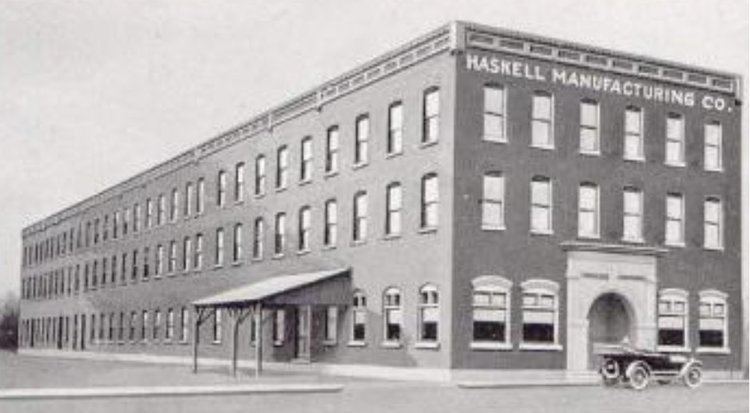 | ||
The Haskell Manufacturing Company was a manufacturer originally based in Ludington, Michigan. Their main product was plywood. They had several subsidiary companies, factories, and offices that were related and supported them.
Contents
History
Henry L. Haskell formed the Haskell Manufacturing Company in 1916 to manufacture plywood. The multi-layered veneer wood panels were called haskelite. The thinner three-layered plywood could be molded into any shape desired. It was used in the construction of canoes, boats, trucks, buses, automobiles, and airplanes. The first plane made with moldable plywood was constructed with Haskelite, and was the Curtiss two-place fighter Whistling Bill.
Henry Haskell established the Haskell Manufacturing Company in the building at 801 N. Rowe Street in Ludington in 1916. This building was originally erected by the Mendelson Manufacturing Company in 1892 for making pianos. They were there for two years and went out of business. The Tubbs Manufacturing Company occupied the building from 1904 to 1911. Haskell's Carrom Company had then moved into this building in 1911 to made the carroms game. Haskell started his manufacturing company officially in the early part of 1916 to make boats and canoes.
Haskell sold his controlling interest in September 1916 to a group of investors from Detroit and New York City. The Haskell Manufacturing Company changed its main focus in 1917 during World War I to build military airplane body parts. The Ludington-based company opened its second plant in Grand Rapids, Michigan, in 1918. This factory was called the Haskelite Manufacturing Corporation. Its main purpose was to supply plywood for the United States and its allies for the construction of military vehicles and aircraft. This factory was twice the size as the original Ludington plant. Between the two factories, there were millions of feet of plywood produced during World War I.
After the war military aircraft were no longer needed and so this use was discontinued and other uses were found for the plywood. One item they built was wooden boats because of the waterproof characteristics of the plywood. Its main product was the Haskell canoe, which was molded from one piece of 3/16th's inch plywood.
In the Grand Rapids factory, "Plymetl" was made, a wooden plywood faced on one side or both with metal (steel or aluminum). One use for this metal-plywood material was for climate controlled facilities (i.e. fur storage, food storage). Another use was for public restroom facilities. One more type of plywood that the company made was "Phemoloid". This finished plywood planking was used in houses, commercial facilities, railroad cars, trucks, airplanes, and luxury automobiles.
Patents
Subsidiaries
Haskell Manufacturing Company had many subsidiaries. One was Marquette Veneer, which made birch Haskelite doors; another company associated was Gillett Log, a Wisconsin company subsidiary that produced the birch wood for the doors.
21st Century
The Haskelite building, as the locals refer to it, on N. Rowe Street was occupied by several different businesses after 1934. Among these were the Civilian Conservation Corps and Wolverine Sportswear Company. Going into the 21st century it has been occupied by the local business Change Parts. These pictures below were taken in the spring of 2016.
